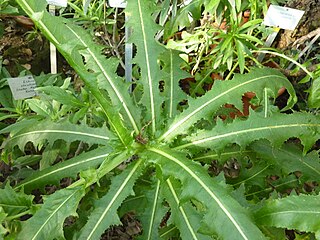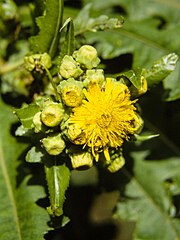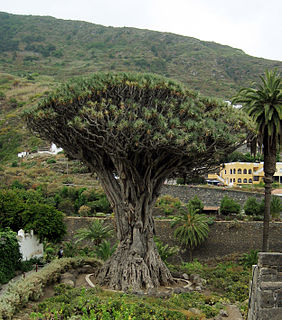
Dracaena draco, the Canary Islands dragon tree or drago, is a subtropical tree in the genus Dracaena, native to the Canary Islands, Cape Verde, Madeira, western Morocco, and is thought to be introduced in the Azores. Its closest living relative is the dragon blood tree of Socotra, Dracaena cinnabari.

Echium wildpretii is a species of flowering plant in the family Boraginaceae. It is an herbaceous biennial plant that grows up to 3 m (10 ft) in height. The species is endemic to the Canary Islands, and is found mainly on Mount Teide in Tenerife. The subspecies E. wildpretii subsp. trichosiphon occurs at high altitudes on the island of La Palma. The common names are tower of jewels, red bugloss, Tenerife bugloss or Mount Teide bugloss. The Spanish name for this plant is tajinaste rojo.

Euphorbia canariensis, commonly known as the Canary Island spurge, Hercules club or in Spanish cardón, is a succulent member of the genus Euphorbia and family Euphorbiaceae endemic to the Canary Islands. It is the plant symbol of the island of Gran Canaria.

Hypericum canariense is a species of flowering plant in the family Hypericaceae known by the common name Canary Islands St. John's wort. It is the sole member of Hypericumsect. Webbia.

Aeonium canariense is a species of flowering plant in the family Crassulaceae. It is endemic to the island of Tenerife in the Canary Islands, where it grows on dry slopes and cliffs in the north of the island from sea level to about 1300m. It forms large rosettes of leaves close to the ground but the spikes of yellow flowers stand up to 70 cm tall.

Geranium reuteri, the giant geranium, is a species of flowering plant in the family Geraniaceae, native to the Canary Islands. It was known for many years under the name Geranium canariense. In Spanish, it is called pata de gallo.

Canarina canariensis is a species of flowering plant in the bellflower family Campanulaceae, commonly known as the Canary Island bellflower, and known locally as bicácaro.

Sonchus palmenis, the La Palma sow-thistle, is a plant endemic to the Canary Island of La Palma.

Sonchus bornmuelleri, or Bornmueller's sow-thistle, is a plant endemic to the Canary Island of La Palma.

Sonchus acaulis is a plant species in the dandelion tribe within the daisy family. It is found only on the Canary Islands of Gran Canaria and Tenerife.

Aeonium sedifolium is a perennial flowering plant in the stonecrop family Crassulaceae. The plant is native to the western Canary Islands of Tenerife, La Gomera and La Palma.
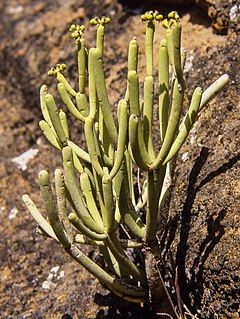
Euphorbia aphylla is a species of flowering plant in the family Euphorbiaceae. It is native to the Canary Islands. It was first described in 1809.

Erysimum scoparium is a species of flowering plant in the family Brassicaceae, native to the Canary Islands. It is a shrubby species of wallflower with purplish flowers found at high altitudes.
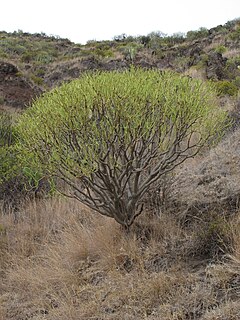
Euphorbia lamarckii is a species of flowering plant in the family Euphorbiaceae, native to the western Canary Islands. It resembles Euphorbia regis-jubae, with which it has been confused. Both have been called Euphorbia obtusifolia.

Euphorbia regis-jubae is a species of flowering plant in the family Euphorbiaceae, native to the eastern Canary Islands, western Morocco, north-western Western Sahara. In Spanish, it is known as tabaiba morisca. It has often been confused with Euphorbia lamarckii.

Aeonium aureum is a species of flowering plant in the family Crassulaceae, native to the Canary Islands. It has very short stems, usually with several leaf rosettes. The grey-green leaves are tightly packed and fleshy. The bright yellow flowers are produced on leafy stems, and are up to 25 mm (1 in) across.

Habenaria tridactylites is a species of flowering plant in the family Orchidaceae, native to the Canary Islands. It was first described by John Lindley in 1835.
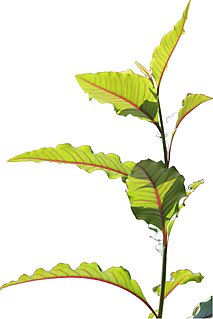
Bosea yervamora Is a shrub up to 3 m with greenish slender branches. Leaves up to 7 cm long, ovate, lanceolate, alternate, short stalked, without hair. Flowers short terminal, arising from the axil of the leaf, indefinite inflorescences, greenish with two membranous, dry modified leaves at the base of the stem. Fruits greenish black turning pink when ripe, about the size of a small pea.

Sonchus canariensis, the tree sonchus, is a species of plant endemic to the Canary Islands.

Sonchus fruticosus, the giant sow thistle, is a species of flowering plant in the dandelion tribe Cichorieae of the daisy family Asteraceae. It is endemic to the islands of Madeira. The giant sow thistle is an impressive shrub native to the Madeiran evergreen forest habitat and growing up to 4 metres in height.

